Australian Law on Euthanasia - Bio Ethics
VerifiedAdded on 2023/06/04
|8
|2388
|150
AI Summary
The essay explores the legal and ethical aspects of Euthanasia in Australia. It discusses the Rights of the Terminally III Act, 1995 and the recent legislation passed in Victoria. It also delves into the application of ethical theories like utilitarianism and deontology. The essay concludes that the topic is subjected to ongoing debates and the legislation is still a year away.
Contribute Materials
Your contribution can guide someone’s learning journey. Share your
documents today.
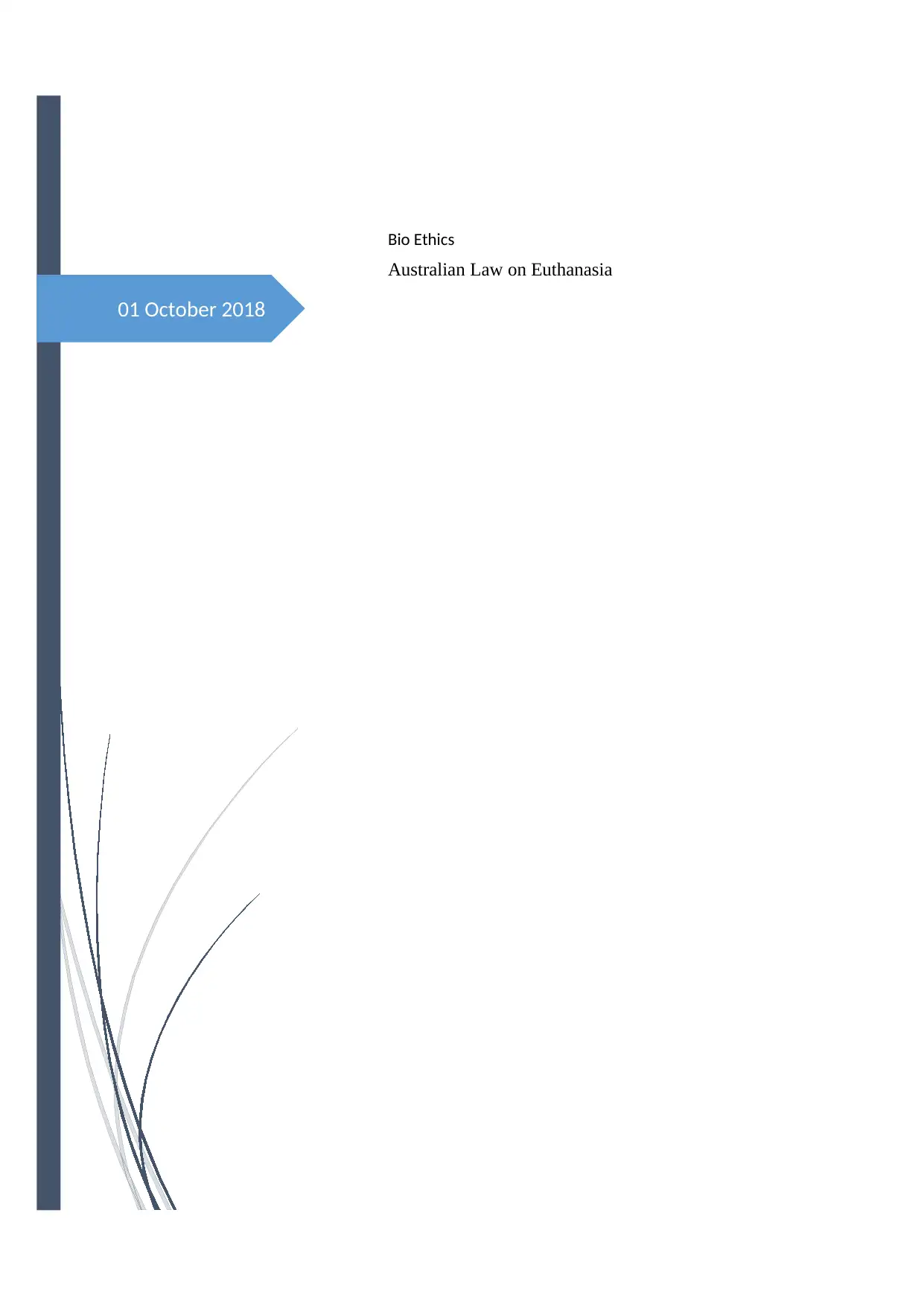
01 October 2018
Bio Ethics
Australian Law on Euthanasia
Bio Ethics
Australian Law on Euthanasia
Secure Best Marks with AI Grader
Need help grading? Try our AI Grader for instant feedback on your assignments.
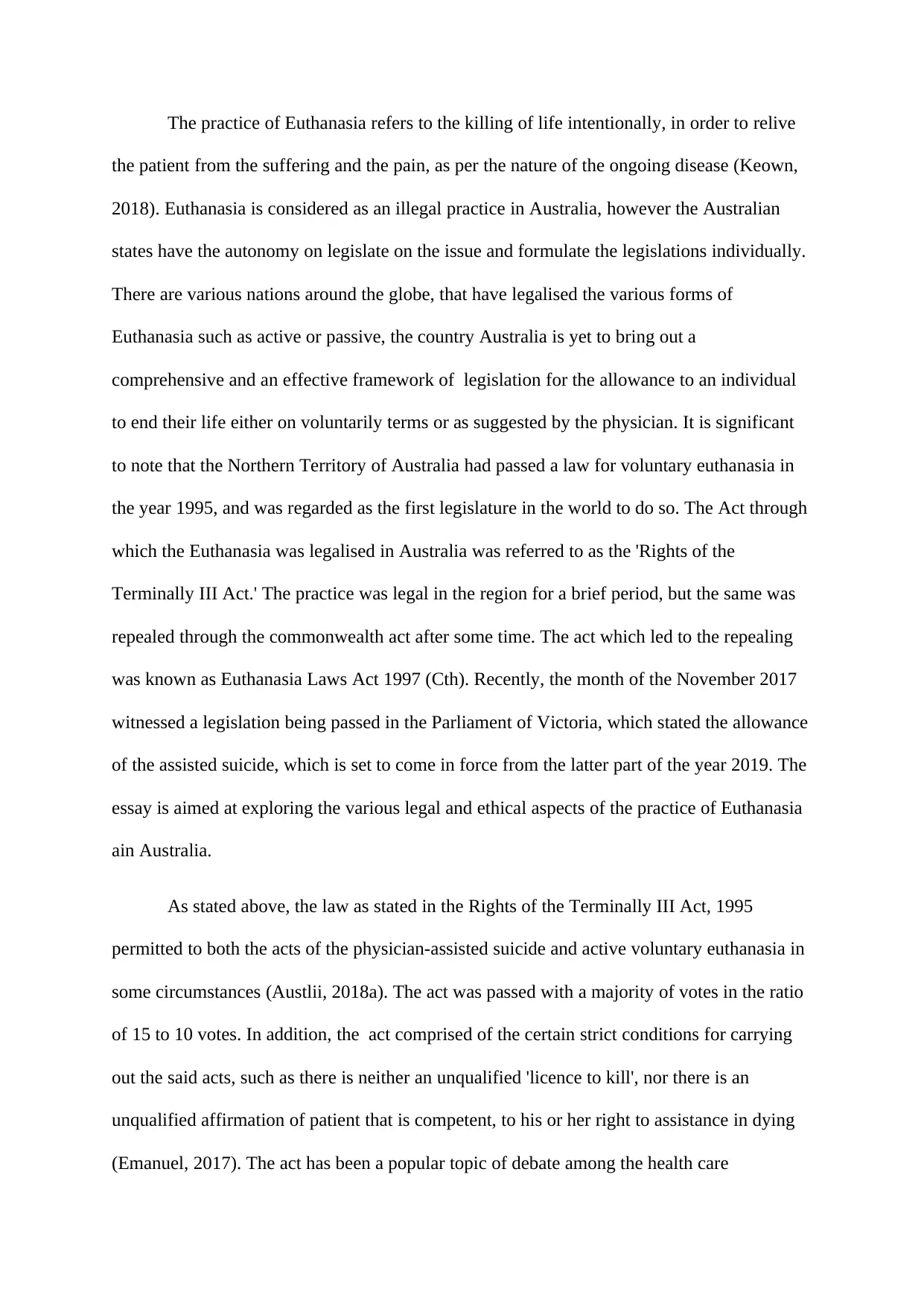
The practice of Euthanasia refers to the killing of life intentionally, in order to relive
the patient from the suffering and the pain, as per the nature of the ongoing disease (Keown,
2018). Euthanasia is considered as an illegal practice in Australia, however the Australian
states have the autonomy on legislate on the issue and formulate the legislations individually.
There are various nations around the globe, that have legalised the various forms of
Euthanasia such as active or passive, the country Australia is yet to bring out a
comprehensive and an effective framework of legislation for the allowance to an individual
to end their life either on voluntarily terms or as suggested by the physician. It is significant
to note that the Northern Territory of Australia had passed a law for voluntary euthanasia in
the year 1995, and was regarded as the first legislature in the world to do so. The Act through
which the Euthanasia was legalised in Australia was referred to as the 'Rights of the
Terminally III Act.' The practice was legal in the region for a brief period, but the same was
repealed through the commonwealth act after some time. The act which led to the repealing
was known as Euthanasia Laws Act 1997 (Cth). Recently, the month of the November 2017
witnessed a legislation being passed in the Parliament of Victoria, which stated the allowance
of the assisted suicide, which is set to come in force from the latter part of the year 2019. The
essay is aimed at exploring the various legal and ethical aspects of the practice of Euthanasia
ain Australia.
As stated above, the law as stated in the Rights of the Terminally III Act, 1995
permitted to both the acts of the physician-assisted suicide and active voluntary euthanasia in
some circumstances (Austlii, 2018a). The act was passed with a majority of votes in the ratio
of 15 to 10 votes. In addition, the act comprised of the certain strict conditions for carrying
out the said acts, such as there is neither an unqualified 'licence to kill', nor there is an
unqualified affirmation of patient that is competent, to his or her right to assistance in dying
(Emanuel, 2017). The act has been a popular topic of debate among the health care
the patient from the suffering and the pain, as per the nature of the ongoing disease (Keown,
2018). Euthanasia is considered as an illegal practice in Australia, however the Australian
states have the autonomy on legislate on the issue and formulate the legislations individually.
There are various nations around the globe, that have legalised the various forms of
Euthanasia such as active or passive, the country Australia is yet to bring out a
comprehensive and an effective framework of legislation for the allowance to an individual
to end their life either on voluntarily terms or as suggested by the physician. It is significant
to note that the Northern Territory of Australia had passed a law for voluntary euthanasia in
the year 1995, and was regarded as the first legislature in the world to do so. The Act through
which the Euthanasia was legalised in Australia was referred to as the 'Rights of the
Terminally III Act.' The practice was legal in the region for a brief period, but the same was
repealed through the commonwealth act after some time. The act which led to the repealing
was known as Euthanasia Laws Act 1997 (Cth). Recently, the month of the November 2017
witnessed a legislation being passed in the Parliament of Victoria, which stated the allowance
of the assisted suicide, which is set to come in force from the latter part of the year 2019. The
essay is aimed at exploring the various legal and ethical aspects of the practice of Euthanasia
ain Australia.
As stated above, the law as stated in the Rights of the Terminally III Act, 1995
permitted to both the acts of the physician-assisted suicide and active voluntary euthanasia in
some circumstances (Austlii, 2018a). The act was passed with a majority of votes in the ratio
of 15 to 10 votes. In addition, the act comprised of the certain strict conditions for carrying
out the said acts, such as there is neither an unqualified 'licence to kill', nor there is an
unqualified affirmation of patient that is competent, to his or her right to assistance in dying
(Emanuel, 2017). The act has been a popular topic of debate among the health care
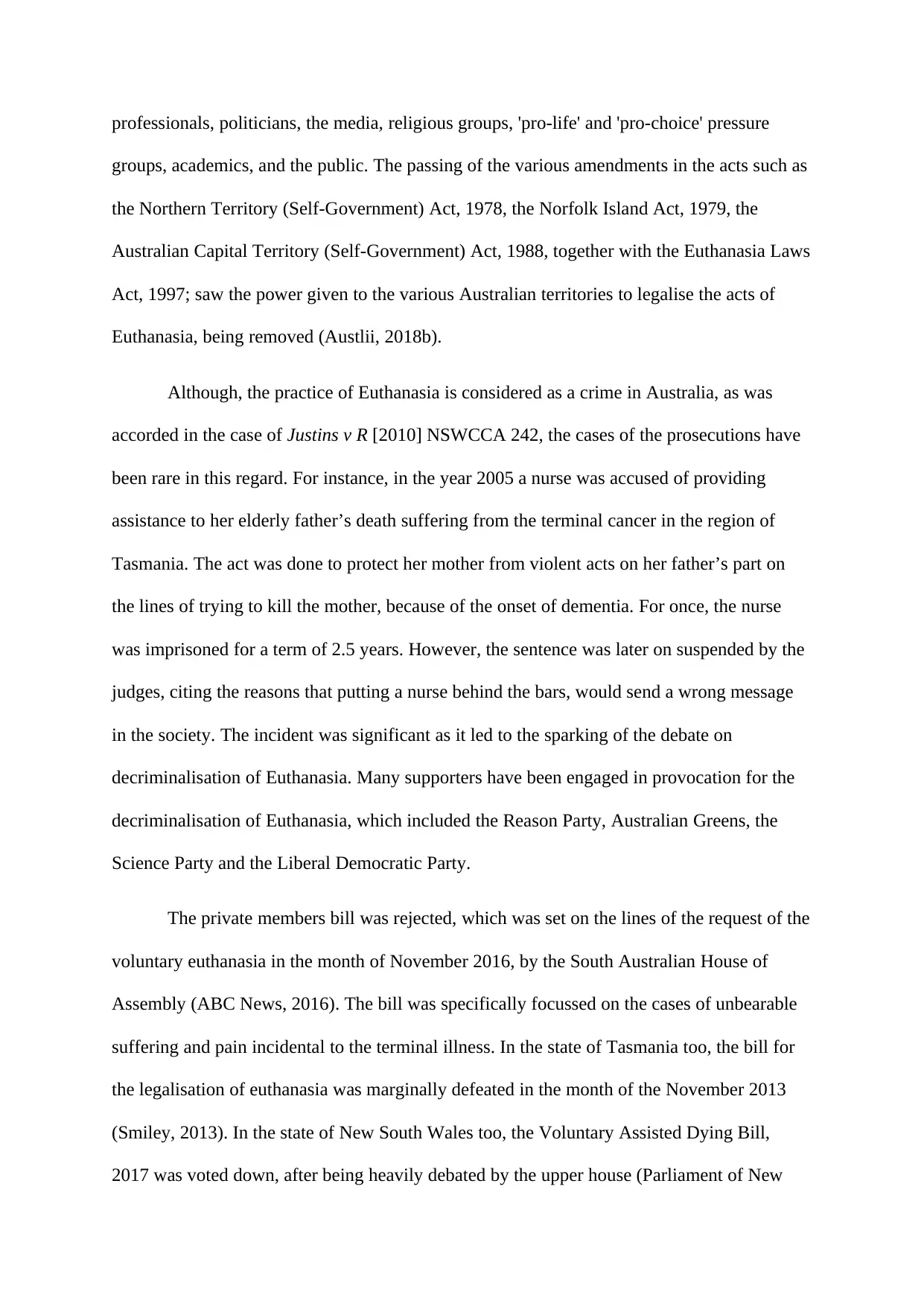
professionals, politicians, the media, religious groups, 'pro-life' and 'pro-choice' pressure
groups, academics, and the public. The passing of the various amendments in the acts such as
the Northern Territory (Self-Government) Act, 1978, the Norfolk Island Act, 1979, the
Australian Capital Territory (Self-Government) Act, 1988, together with the Euthanasia Laws
Act, 1997; saw the power given to the various Australian territories to legalise the acts of
Euthanasia, being removed (Austlii, 2018b).
Although, the practice of Euthanasia is considered as a crime in Australia, as was
accorded in the case of Justins v R [2010] NSWCCA 242, the cases of the prosecutions have
been rare in this regard. For instance, in the year 2005 a nurse was accused of providing
assistance to her elderly father’s death suffering from the terminal cancer in the region of
Tasmania. The act was done to protect her mother from violent acts on her father’s part on
the lines of trying to kill the mother, because of the onset of dementia. For once, the nurse
was imprisoned for a term of 2.5 years. However, the sentence was later on suspended by the
judges, citing the reasons that putting a nurse behind the bars, would send a wrong message
in the society. The incident was significant as it led to the sparking of the debate on
decriminalisation of Euthanasia. Many supporters have been engaged in provocation for the
decriminalisation of Euthanasia, which included the Reason Party, Australian Greens, the
Science Party and the Liberal Democratic Party.
The private members bill was rejected, which was set on the lines of the request of the
voluntary euthanasia in the month of November 2016, by the South Australian House of
Assembly (ABC News, 2016). The bill was specifically focussed on the cases of unbearable
suffering and pain incidental to the terminal illness. In the state of Tasmania too, the bill for
the legalisation of euthanasia was marginally defeated in the month of the November 2013
(Smiley, 2013). In the state of New South Wales too, the Voluntary Assisted Dying Bill,
2017 was voted down, after being heavily debated by the upper house (Parliament of New
groups, academics, and the public. The passing of the various amendments in the acts such as
the Northern Territory (Self-Government) Act, 1978, the Norfolk Island Act, 1979, the
Australian Capital Territory (Self-Government) Act, 1988, together with the Euthanasia Laws
Act, 1997; saw the power given to the various Australian territories to legalise the acts of
Euthanasia, being removed (Austlii, 2018b).
Although, the practice of Euthanasia is considered as a crime in Australia, as was
accorded in the case of Justins v R [2010] NSWCCA 242, the cases of the prosecutions have
been rare in this regard. For instance, in the year 2005 a nurse was accused of providing
assistance to her elderly father’s death suffering from the terminal cancer in the region of
Tasmania. The act was done to protect her mother from violent acts on her father’s part on
the lines of trying to kill the mother, because of the onset of dementia. For once, the nurse
was imprisoned for a term of 2.5 years. However, the sentence was later on suspended by the
judges, citing the reasons that putting a nurse behind the bars, would send a wrong message
in the society. The incident was significant as it led to the sparking of the debate on
decriminalisation of Euthanasia. Many supporters have been engaged in provocation for the
decriminalisation of Euthanasia, which included the Reason Party, Australian Greens, the
Science Party and the Liberal Democratic Party.
The private members bill was rejected, which was set on the lines of the request of the
voluntary euthanasia in the month of November 2016, by the South Australian House of
Assembly (ABC News, 2016). The bill was specifically focussed on the cases of unbearable
suffering and pain incidental to the terminal illness. In the state of Tasmania too, the bill for
the legalisation of euthanasia was marginally defeated in the month of the November 2013
(Smiley, 2013). In the state of New South Wales too, the Voluntary Assisted Dying Bill,
2017 was voted down, after being heavily debated by the upper house (Parliament of New
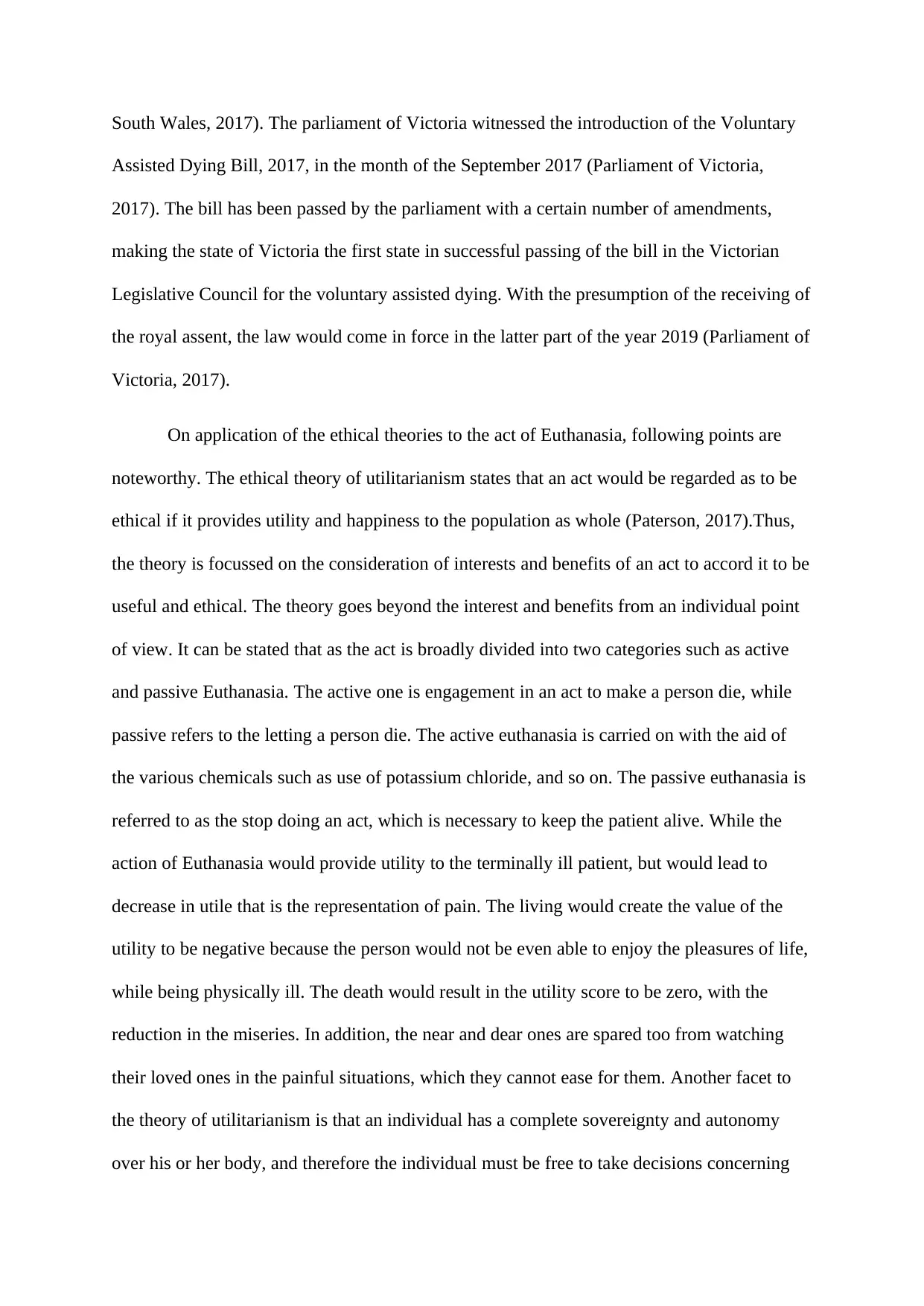
South Wales, 2017). The parliament of Victoria witnessed the introduction of the Voluntary
Assisted Dying Bill, 2017, in the month of the September 2017 (Parliament of Victoria,
2017). The bill has been passed by the parliament with a certain number of amendments,
making the state of Victoria the first state in successful passing of the bill in the Victorian
Legislative Council for the voluntary assisted dying. With the presumption of the receiving of
the royal assent, the law would come in force in the latter part of the year 2019 (Parliament of
Victoria, 2017).
On application of the ethical theories to the act of Euthanasia, following points are
noteworthy. The ethical theory of utilitarianism states that an act would be regarded as to be
ethical if it provides utility and happiness to the population as whole (Paterson, 2017).Thus,
the theory is focussed on the consideration of interests and benefits of an act to accord it to be
useful and ethical. The theory goes beyond the interest and benefits from an individual point
of view. It can be stated that as the act is broadly divided into two categories such as active
and passive Euthanasia. The active one is engagement in an act to make a person die, while
passive refers to the letting a person die. The active euthanasia is carried on with the aid of
the various chemicals such as use of potassium chloride, and so on. The passive euthanasia is
referred to as the stop doing an act, which is necessary to keep the patient alive. While the
action of Euthanasia would provide utility to the terminally ill patient, but would lead to
decrease in utile that is the representation of pain. The living would create the value of the
utility to be negative because the person would not be even able to enjoy the pleasures of life,
while being physically ill. The death would result in the utility score to be zero, with the
reduction in the miseries. In addition, the near and dear ones are spared too from watching
their loved ones in the painful situations, which they cannot ease for them. Another facet to
the theory of utilitarianism is that an individual has a complete sovereignty and autonomy
over his or her body, and therefore the individual must be free to take decisions concerning
Assisted Dying Bill, 2017, in the month of the September 2017 (Parliament of Victoria,
2017). The bill has been passed by the parliament with a certain number of amendments,
making the state of Victoria the first state in successful passing of the bill in the Victorian
Legislative Council for the voluntary assisted dying. With the presumption of the receiving of
the royal assent, the law would come in force in the latter part of the year 2019 (Parliament of
Victoria, 2017).
On application of the ethical theories to the act of Euthanasia, following points are
noteworthy. The ethical theory of utilitarianism states that an act would be regarded as to be
ethical if it provides utility and happiness to the population as whole (Paterson, 2017).Thus,
the theory is focussed on the consideration of interests and benefits of an act to accord it to be
useful and ethical. The theory goes beyond the interest and benefits from an individual point
of view. It can be stated that as the act is broadly divided into two categories such as active
and passive Euthanasia. The active one is engagement in an act to make a person die, while
passive refers to the letting a person die. The active euthanasia is carried on with the aid of
the various chemicals such as use of potassium chloride, and so on. The passive euthanasia is
referred to as the stop doing an act, which is necessary to keep the patient alive. While the
action of Euthanasia would provide utility to the terminally ill patient, but would lead to
decrease in utile that is the representation of pain. The living would create the value of the
utility to be negative because the person would not be even able to enjoy the pleasures of life,
while being physically ill. The death would result in the utility score to be zero, with the
reduction in the miseries. In addition, the near and dear ones are spared too from watching
their loved ones in the painful situations, which they cannot ease for them. Another facet to
the theory of utilitarianism is that an individual has a complete sovereignty and autonomy
over his or her body, and therefore the individual must be free to take decisions concerning
Secure Best Marks with AI Grader
Need help grading? Try our AI Grader for instant feedback on your assignments.
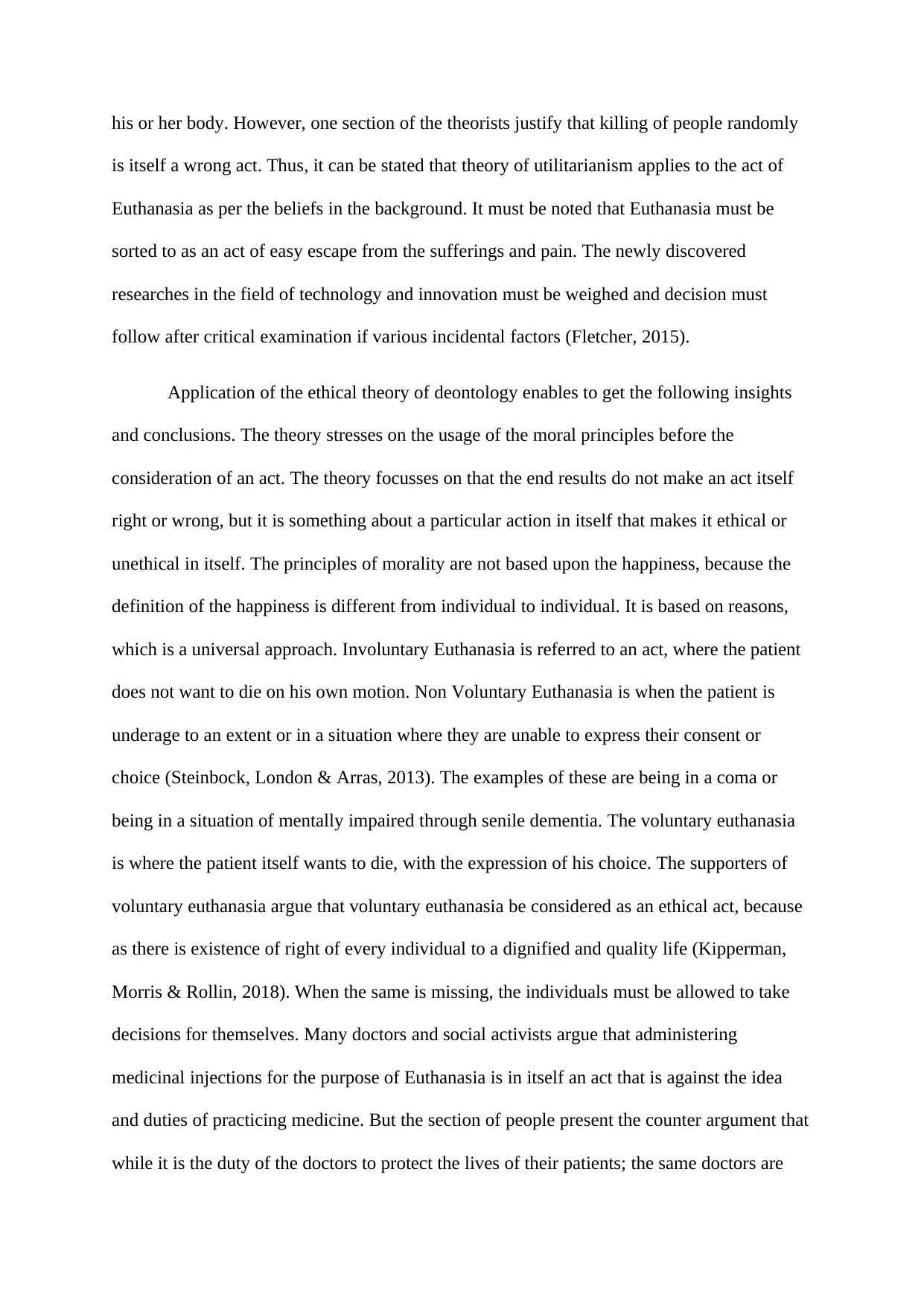
his or her body. However, one section of the theorists justify that killing of people randomly
is itself a wrong act. Thus, it can be stated that theory of utilitarianism applies to the act of
Euthanasia as per the beliefs in the background. It must be noted that Euthanasia must be
sorted to as an act of easy escape from the sufferings and pain. The newly discovered
researches in the field of technology and innovation must be weighed and decision must
follow after critical examination if various incidental factors (Fletcher, 2015).
Application of the ethical theory of deontology enables to get the following insights
and conclusions. The theory stresses on the usage of the moral principles before the
consideration of an act. The theory focusses on that the end results do not make an act itself
right or wrong, but it is something about a particular action in itself that makes it ethical or
unethical in itself. The principles of morality are not based upon the happiness, because the
definition of the happiness is different from individual to individual. It is based on reasons,
which is a universal approach. Involuntary Euthanasia is referred to an act, where the patient
does not want to die on his own motion. Non Voluntary Euthanasia is when the patient is
underage to an extent or in a situation where they are unable to express their consent or
choice (Steinbock, London & Arras, 2013). The examples of these are being in a coma or
being in a situation of mentally impaired through senile dementia. The voluntary euthanasia
is where the patient itself wants to die, with the expression of his choice. The supporters of
voluntary euthanasia argue that voluntary euthanasia be considered as an ethical act, because
as there is existence of right of every individual to a dignified and quality life (Kipperman,
Morris & Rollin, 2018). When the same is missing, the individuals must be allowed to take
decisions for themselves. Many doctors and social activists argue that administering
medicinal injections for the purpose of Euthanasia is in itself an act that is against the idea
and duties of practicing medicine. But the section of people present the counter argument that
while it is the duty of the doctors to protect the lives of their patients; the same doctors are
is itself a wrong act. Thus, it can be stated that theory of utilitarianism applies to the act of
Euthanasia as per the beliefs in the background. It must be noted that Euthanasia must be
sorted to as an act of easy escape from the sufferings and pain. The newly discovered
researches in the field of technology and innovation must be weighed and decision must
follow after critical examination if various incidental factors (Fletcher, 2015).
Application of the ethical theory of deontology enables to get the following insights
and conclusions. The theory stresses on the usage of the moral principles before the
consideration of an act. The theory focusses on that the end results do not make an act itself
right or wrong, but it is something about a particular action in itself that makes it ethical or
unethical in itself. The principles of morality are not based upon the happiness, because the
definition of the happiness is different from individual to individual. It is based on reasons,
which is a universal approach. Involuntary Euthanasia is referred to an act, where the patient
does not want to die on his own motion. Non Voluntary Euthanasia is when the patient is
underage to an extent or in a situation where they are unable to express their consent or
choice (Steinbock, London & Arras, 2013). The examples of these are being in a coma or
being in a situation of mentally impaired through senile dementia. The voluntary euthanasia
is where the patient itself wants to die, with the expression of his choice. The supporters of
voluntary euthanasia argue that voluntary euthanasia be considered as an ethical act, because
as there is existence of right of every individual to a dignified and quality life (Kipperman,
Morris & Rollin, 2018). When the same is missing, the individuals must be allowed to take
decisions for themselves. Many doctors and social activists argue that administering
medicinal injections for the purpose of Euthanasia is in itself an act that is against the idea
and duties of practicing medicine. But the section of people present the counter argument that
while it is the duty of the doctors to protect the lives of their patients; the same doctors are
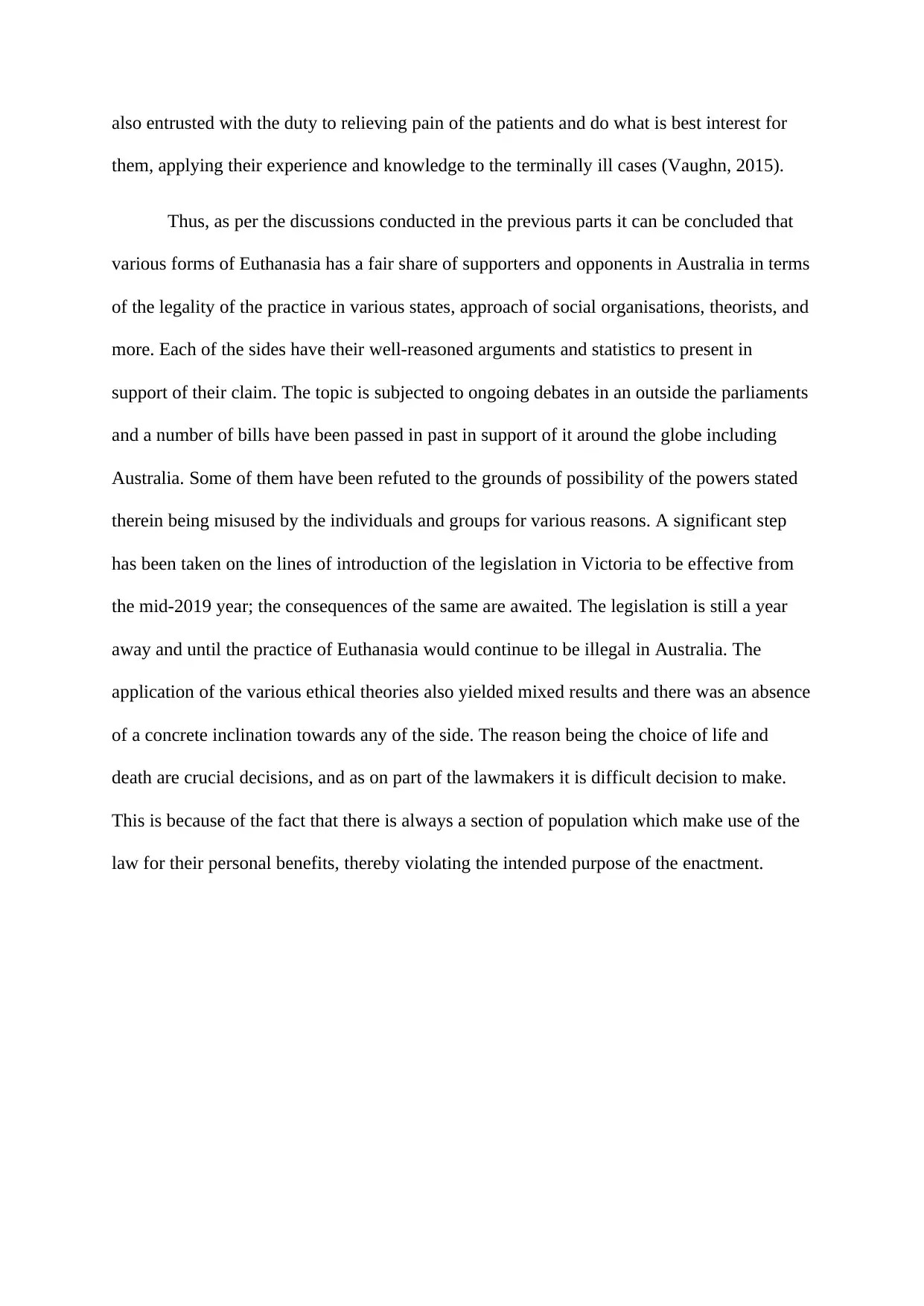
also entrusted with the duty to relieving pain of the patients and do what is best interest for
them, applying their experience and knowledge to the terminally ill cases (Vaughn, 2015).
Thus, as per the discussions conducted in the previous parts it can be concluded that
various forms of Euthanasia has a fair share of supporters and opponents in Australia in terms
of the legality of the practice in various states, approach of social organisations, theorists, and
more. Each of the sides have their well-reasoned arguments and statistics to present in
support of their claim. The topic is subjected to ongoing debates in an outside the parliaments
and a number of bills have been passed in past in support of it around the globe including
Australia. Some of them have been refuted to the grounds of possibility of the powers stated
therein being misused by the individuals and groups for various reasons. A significant step
has been taken on the lines of introduction of the legislation in Victoria to be effective from
the mid-2019 year; the consequences of the same are awaited. The legislation is still a year
away and until the practice of Euthanasia would continue to be illegal in Australia. The
application of the various ethical theories also yielded mixed results and there was an absence
of a concrete inclination towards any of the side. The reason being the choice of life and
death are crucial decisions, and as on part of the lawmakers it is difficult decision to make.
This is because of the fact that there is always a section of population which make use of the
law for their personal benefits, thereby violating the intended purpose of the enactment.
them, applying their experience and knowledge to the terminally ill cases (Vaughn, 2015).
Thus, as per the discussions conducted in the previous parts it can be concluded that
various forms of Euthanasia has a fair share of supporters and opponents in Australia in terms
of the legality of the practice in various states, approach of social organisations, theorists, and
more. Each of the sides have their well-reasoned arguments and statistics to present in
support of their claim. The topic is subjected to ongoing debates in an outside the parliaments
and a number of bills have been passed in past in support of it around the globe including
Australia. Some of them have been refuted to the grounds of possibility of the powers stated
therein being misused by the individuals and groups for various reasons. A significant step
has been taken on the lines of introduction of the legislation in Victoria to be effective from
the mid-2019 year; the consequences of the same are awaited. The legislation is still a year
away and until the practice of Euthanasia would continue to be illegal in Australia. The
application of the various ethical theories also yielded mixed results and there was an absence
of a concrete inclination towards any of the side. The reason being the choice of life and
death are crucial decisions, and as on part of the lawmakers it is difficult decision to make.
This is because of the fact that there is always a section of population which make use of the
law for their personal benefits, thereby violating the intended purpose of the enactment.
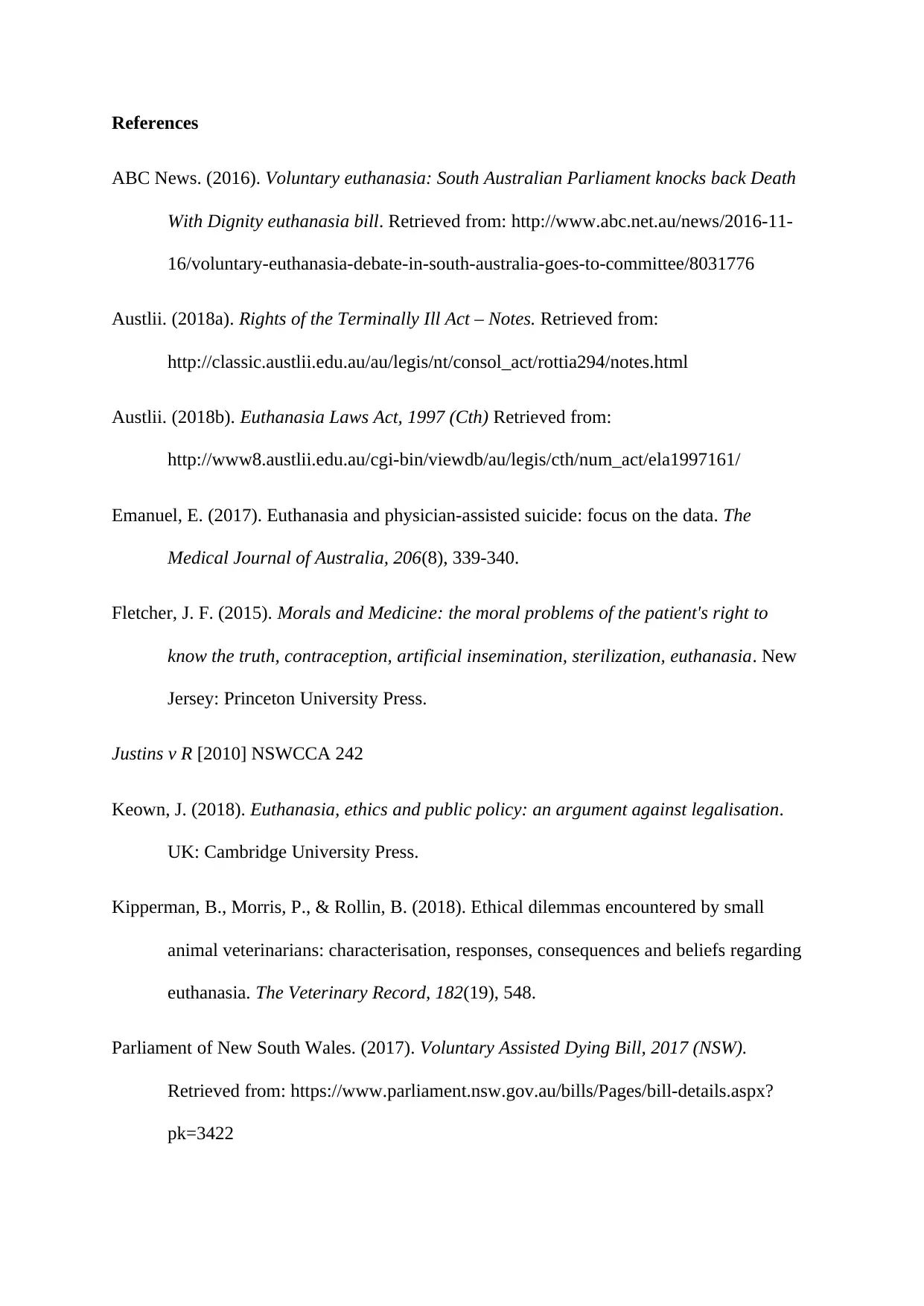
References
ABC News. (2016). Voluntary euthanasia: South Australian Parliament knocks back Death
With Dignity euthanasia bill. Retrieved from: http://www.abc.net.au/news/2016-11-
16/voluntary-euthanasia-debate-in-south-australia-goes-to-committee/8031776
Austlii. (2018a). Rights of the Terminally Ill Act – Notes. Retrieved from:
http://classic.austlii.edu.au/au/legis/nt/consol_act/rottia294/notes.html
Austlii. (2018b). Euthanasia Laws Act, 1997 (Cth) Retrieved from:
http://www8.austlii.edu.au/cgi-bin/viewdb/au/legis/cth/num_act/ela1997161/
Emanuel, E. (2017). Euthanasia and physician-assisted suicide: focus on the data. The
Medical Journal of Australia, 206(8), 339-340.
Fletcher, J. F. (2015). Morals and Medicine: the moral problems of the patient's right to
know the truth, contraception, artificial insemination, sterilization, euthanasia. New
Jersey: Princeton University Press.
Justins v R [2010] NSWCCA 242
Keown, J. (2018). Euthanasia, ethics and public policy: an argument against legalisation.
UK: Cambridge University Press.
Kipperman, B., Morris, P., & Rollin, B. (2018). Ethical dilemmas encountered by small
animal veterinarians: characterisation, responses, consequences and beliefs regarding
euthanasia. The Veterinary Record, 182(19), 548.
Parliament of New South Wales. (2017). Voluntary Assisted Dying Bill, 2017 (NSW).
Retrieved from: https://www.parliament.nsw.gov.au/bills/Pages/bill-details.aspx?
pk=3422
ABC News. (2016). Voluntary euthanasia: South Australian Parliament knocks back Death
With Dignity euthanasia bill. Retrieved from: http://www.abc.net.au/news/2016-11-
16/voluntary-euthanasia-debate-in-south-australia-goes-to-committee/8031776
Austlii. (2018a). Rights of the Terminally Ill Act – Notes. Retrieved from:
http://classic.austlii.edu.au/au/legis/nt/consol_act/rottia294/notes.html
Austlii. (2018b). Euthanasia Laws Act, 1997 (Cth) Retrieved from:
http://www8.austlii.edu.au/cgi-bin/viewdb/au/legis/cth/num_act/ela1997161/
Emanuel, E. (2017). Euthanasia and physician-assisted suicide: focus on the data. The
Medical Journal of Australia, 206(8), 339-340.
Fletcher, J. F. (2015). Morals and Medicine: the moral problems of the patient's right to
know the truth, contraception, artificial insemination, sterilization, euthanasia. New
Jersey: Princeton University Press.
Justins v R [2010] NSWCCA 242
Keown, J. (2018). Euthanasia, ethics and public policy: an argument against legalisation.
UK: Cambridge University Press.
Kipperman, B., Morris, P., & Rollin, B. (2018). Ethical dilemmas encountered by small
animal veterinarians: characterisation, responses, consequences and beliefs regarding
euthanasia. The Veterinary Record, 182(19), 548.
Parliament of New South Wales. (2017). Voluntary Assisted Dying Bill, 2017 (NSW).
Retrieved from: https://www.parliament.nsw.gov.au/bills/Pages/bill-details.aspx?
pk=3422
Paraphrase This Document
Need a fresh take? Get an instant paraphrase of this document with our AI Paraphraser
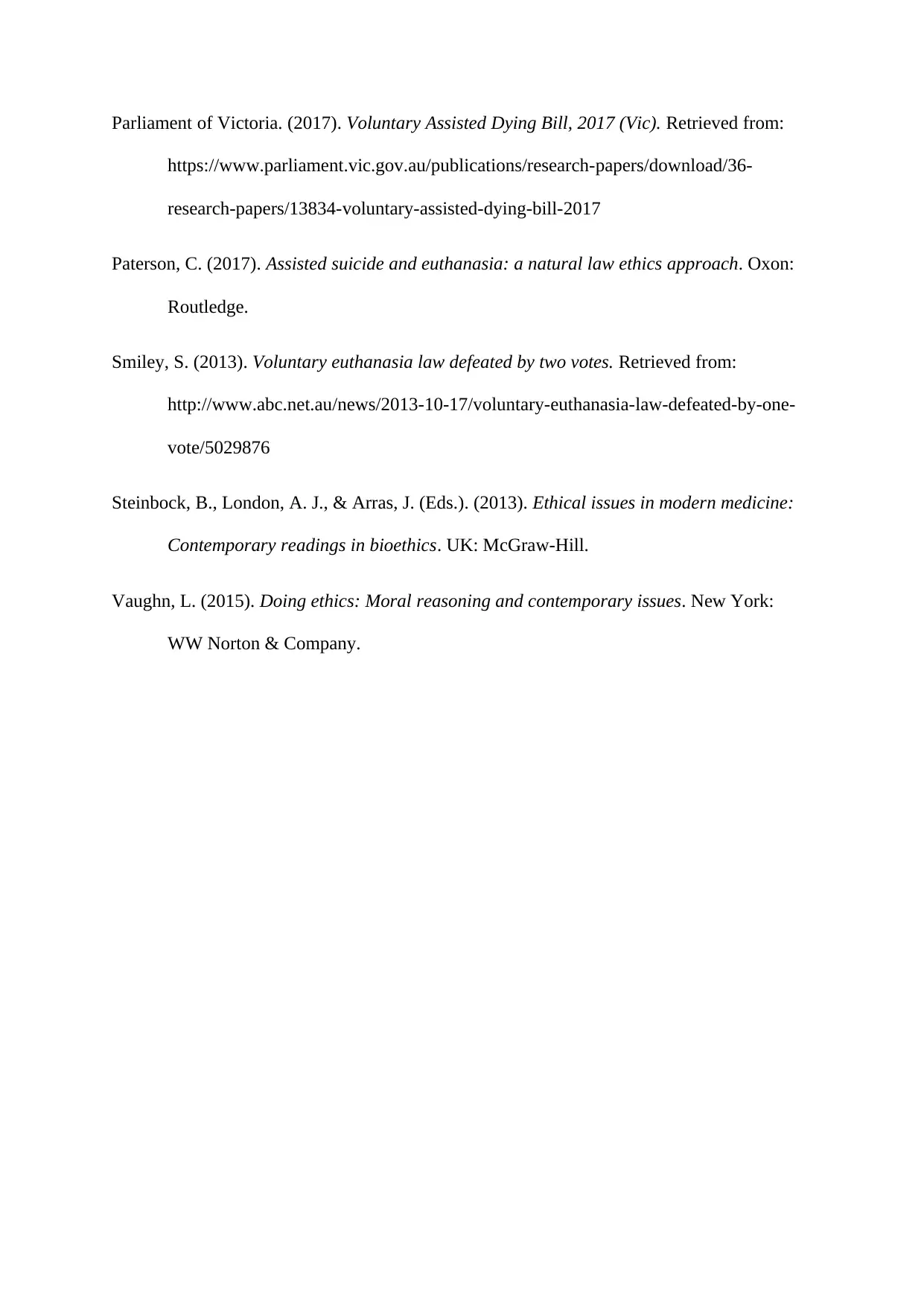
Parliament of Victoria. (2017). Voluntary Assisted Dying Bill, 2017 (Vic). Retrieved from:
https://www.parliament.vic.gov.au/publications/research-papers/download/36-
research-papers/13834-voluntary-assisted-dying-bill-2017
Paterson, C. (2017). Assisted suicide and euthanasia: a natural law ethics approach. Oxon:
Routledge.
Smiley, S. (2013). Voluntary euthanasia law defeated by two votes. Retrieved from:
http://www.abc.net.au/news/2013-10-17/voluntary-euthanasia-law-defeated-by-one-
vote/5029876
Steinbock, B., London, A. J., & Arras, J. (Eds.). (2013). Ethical issues in modern medicine:
Contemporary readings in bioethics. UK: McGraw-Hill.
Vaughn, L. (2015). Doing ethics: Moral reasoning and contemporary issues. New York:
WW Norton & Company.
https://www.parliament.vic.gov.au/publications/research-papers/download/36-
research-papers/13834-voluntary-assisted-dying-bill-2017
Paterson, C. (2017). Assisted suicide and euthanasia: a natural law ethics approach. Oxon:
Routledge.
Smiley, S. (2013). Voluntary euthanasia law defeated by two votes. Retrieved from:
http://www.abc.net.au/news/2013-10-17/voluntary-euthanasia-law-defeated-by-one-
vote/5029876
Steinbock, B., London, A. J., & Arras, J. (Eds.). (2013). Ethical issues in modern medicine:
Contemporary readings in bioethics. UK: McGraw-Hill.
Vaughn, L. (2015). Doing ethics: Moral reasoning and contemporary issues. New York:
WW Norton & Company.
1 out of 8
Your All-in-One AI-Powered Toolkit for Academic Success.
+13062052269
info@desklib.com
Available 24*7 on WhatsApp / Email
![[object Object]](/_next/static/media/star-bottom.7253800d.svg)
Unlock your academic potential
© 2024 | Zucol Services PVT LTD | All rights reserved.

